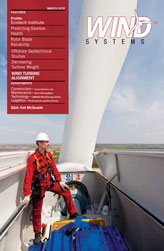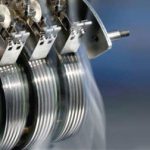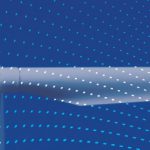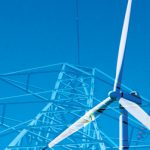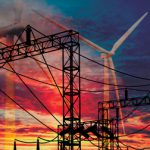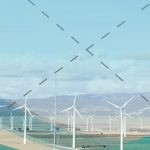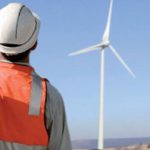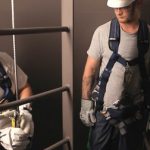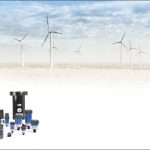Wind energy is one of the world’s fastest-growing sources of energy. According to a 2011 report provided by the World Wind Energy Association, China, the United States, Germany, Spain, and India were the top five wind power markets by total capacity in 2010. When it comes to producing wind turbine components as efficiently and inexpensively as some of these countries, however, the United States tends to lag behind. Why is that, and what can be done?
Embracing Efficiency
Europe, for example, is capable of producing wind turbine components at much more affordable levels than the United States. The Europeans follow the mindset that they will invest in the right equipment to make these components as quickly and cost effectively as possible. In fact, they use large, high-powered machines to achieve fast metal removal rates and shorter cycle times.
The United States has not been able to mimic Europe’s efficient machining practices because not enough incentive funding exists for wind turbine manufacturers to want to move forward in improving their processes. For example, the oil and gas industry receives higher tax incentives than wind power. Furthermore, wind power manufacturers must renew their federal subsidies on an annual basis, making it difficult for them to gauge how stable the wind industry is going to be from one year to the next. Figure 1
The current reality in the United States is that several wind turbine manufacturers have evolved from automotive-type companies who are continuing to utilize their existing machine tool equipment to produce turbine components. These machines are older, slower, and less powerful than what Europe is using to machine their parts. To put it in perspective, Europeans can produce a wind turbine rotor hub in four to five hours, whereas it takes a U.S. manufacturer eight or more hours. All the while, OEMs are putting a lot of pressure on American manufacturers to reduce manufacturing costs.
Materials Matter
On a brighter note, some U.S. manufacturers are contemplating the use of lighter, stronger materials such as carbon fiber, compacted graphite iron (CGI), aluminum, and titanium alloy to lower the cost of industrial wind turbines. After all, the heavier the wind turbine, the more costly it is to produce, transport, and install.
The larger OEMs, in particular, are actively looking into materials with improved strength-to-weight ratio for wind turbines out on the ocean. Offshore turbines tend to be a lot larger than those on land, and installation is a lot more difficult and expensive. Therefore, being able to reduce their weight is a big deal. Should this become a successful trend, more manufacturers of land wind turbines will be apt to follow suit.
Consider the land-based 5MW wind turbine of today, which weighs more than 1.1 million pounds, with the nacelle, rotor hub, and blades accounting for most of the weight. If manufacturers started making these three main wind turbine components out of lighter material, they could probably cut the weight of the 5MW in half. As a result, the tower portion—which typically weighs several hundred tons—can undergo a considerable weight reduction because it would only have to support approximately 551,000 pounds instead of over a million. Furthermore, the wind turbine’s foundation could also see a decrease in size.
Today, wind turbine blades are typically made of fiberglass and assembled by hand. If manufacturers transitioned over to carbon fiber materials and invested in a CNC process, the weight of the blades would decrease by about 70 percent and their strength and consistency levels would improve overall. However, carbon fiber costs more: a fact that deserves attention when looking at the overall savings of building a complete wind turbine. It’s also important to note that manufacturers can’t reduce the size of the blades to save money because the area of the blades that “catches” the wind must remain the same size.
Rotor hubs are currently made of ductile cast iron. However, a better alternative exists with compacted graphite iron because of its improved strength-to-weight ratio. It features mechanical and physical properties between those of ductile and gray irons. CGI’s graphite particles are short and thick, resulting in stronger adhesion between the graphite and iron for greater tensile strength. Such properties make CGI more resilient to mechanical and chemical fatigue and are highly favored in applications ranging from high-speed rail train disc brakes to engine blocks. And because of its benefits, several wind turbine manufacturers are starting to have rotor hub test pieces made out of CGI.
Attractive Alloys
Aluminum is another material the wind turbine industry is considering for manufacturing rotor hubs because it is approximately â
the weight of steel and provides corrosion resistance. Titanium alloy is another choice that offers excellent strength-to-weight ratio, but it comes at a higher price. Therefore, when looking to reduce rotor hub weight through CGI, aluminum or titanium alloy, manufacturers need to evaluate which material will offer the best overall weight, strength and price ratio for their operations. Figure 2
Although manufacturers can reduce the actual size of the rotor hub to eliminate weight, the hub still has to be able to withstand strong wind forces and successfully transfer the torque to the mainshaft/gearbox or generator on a direct drive system. Therefore, choosing a lighter, stronger material to produce the rotor hub is more likely the best option in terms of weight reduction.
When looking to reduce the weight of ancillary wind turbine components such as bearings, the bearing house, shaft, and gearbox, manufacturers need to go through the same weight, strength, and price ration routine to see what material is going to reap the best benefits for their businesses.
Beyond the wind turbine itself, when manufacturers reduce the weight of turbine components, they are also lessening their manufacturing efforts. For example, the size of the equipment they use—from machines to forklifts—doesn’t have to be as large to accommodate such hefty parts.
Cutting Edges
There are, however, some challenges when transitioning over to some of the lighter, stronger materials. For example, if a shop is currently machining rotor hubs made of ductile cast iron and wants to start using aluminum, the shop would need to update its tooling, reprogram its parts for different cutting techniques, and adjust its speeds and feeds for the tooling. Another challenge is the hazardous dust that comes with machining carbon fiber materials. Shops would need to have special equipment to keep the carbon fiber particles from contaminating the air.
But for those wind component manufacturers ready to start a weight-loss trend, Seco has extensive experience in working with carbon fiber, compacted graphite iron, aluminum, and titanium alloy. After all, the company’s cutting tools have long played a role in machining these weight-reducing materials within the aerospace and power generation markets.
Such cutting tools include Seco’s Turbo square shoulder mill. Available in four different insert sizes, the Turbo offers improved tool life and precision by optimizing cutting properties that reduce heat generation and cutting forces. Another ideal milling solution is the company’s Double Octomill™ that features 16 cutting edges and provides excellent cost effectiveness. It handles roughing and finishing by accurately positioning its inserts inside the cutter body pockets using high-speed steel location pins that offer easy and secure indexing. The Double Octomill also provides extremely fast metal removal rates and can greatly reduce cycle times when machining a wind turbine component.
Additionally, some of Seco’s cutting geometries are free cutting, which is important because they increase stability in long-reach applications, which are common in wind turbine component manufacturing.
Steady Systems
When tackling long-reach applications, Seco’s patented Steadyline™ vibration dampening system, made of high tensile steel, improves the dynamic rigidity of milling assemblies. In a typical long overhang milling operation, the Steadyline provides increased tool life as well as performs twice as fast as a classic system. Steadyline shell mill holders are available in a wide range of types and sizes, including cylindrical, conically strengthened, HSK, Seco-Capto, DIN, BT, and CAT.
Other relevant Seco tools for the wind power industry include a complete range of drilling, reaming, and boring tools such as Feedmax™ solid carbide drills and Perfomax® indexable insert drills, X-fix™ large diameter, multi-tooth reamers, and the Graflex® boring bar system of various lengths and diameters. In fact, with its wide variety of holemaking tools Seco offers the widest boring range on the market, covering the entire 0.12” to 84.843” diameter range with complete precision.
While Seco can optimize most machining operations with its comprehensive tooling portfolio, the company can also provide turbine manufacturers with custom tooling solutions that maximize their unique wind power operations.
Production Partner
For those just getting started in the wind turbine component industry, Seco offers a Component Engineering Tooling (CET) program that takes a comprehensive approach to process design and improvement that ensures the best possible operational results. As part of the program, the CET team—which consists of expert engineers—conducts technology evaluations to ensure a company’s manufacturing process incorporates the most suitable equipment. Functional testing can also take place inside one of Seco labs to prove out a machining solution prior to implementation. The Seco team then executes an integration plan of the selected equipment, including technical support and training, implementation of the system, run-off tests, and documentation of potential savings. Several wind customers have taken advantage of this program and managed to save time and money before any parts hit the manufacturing floor.
Current wind turbine component manufacturers looking to improve their productivity and profitability via their existing operations are encouraged to take advantage of Seco’s Productivity and Cost Analysis (PCA), which represents a total evaluation of a manufacturing process using Seco’s unique software program. The PCA begins with Seco working closely with a manufacturer’s employees to understand and benchmark the company’s current efforts. The software program allows Seco to verify and gain a baseline of any type of component. In fact, the software goes step-by-step with each tool and process as a way to put together a “snapshot” of an entire manufacturing process.
Seco then draws upon the expertise of its global resources to identify, investigate and prove out recommendations for reducing costs, increasing throughput and maximizing efficiency. Typical results from a fully executed PCA include cost reductions of up to 30 percent and productivity increases of up to 40 percent. Manufacturers can also tailor a PCA to meet a specific need, from assessing a single machining application to evaluating workflow throughout the company’s entire facility.
Summary
Wind is among the most affordable renewable energy resource on the planet. However, in order to cost-effectively cultivate more wind farms in the United States, a trend toward using more efficient equipment and weight-reducing materials in the development of wind turbine components must first occur. Manufacturers should know they are not alone in such a movement, however, because Seco is ready to help them pave the way with its optimized machining solutions.



















